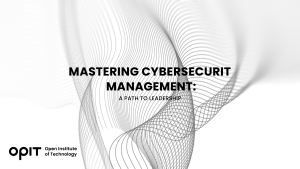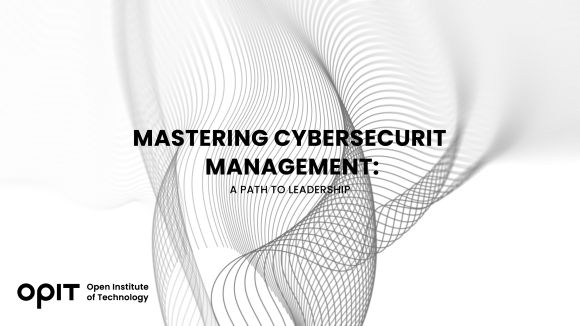

Have you ever thought about how businesses keep their digital assets under a tight lock?
Companies have a secret weapon against cyberattacks – a specialist with a Master of Science in Cybersecurity Management and Policy. Keeping digital assets may seem effortless, but it’s no small feat, especially with hackers getting more prolific by the minute. The specialists are the ones who lead the charge in the fight for cybersecurity.
This degree is your golden ticket to moving up the ranks and becoming the master of cyber defense strategy who knows how to keep information safe against all odds. It bridges technical skills and strategic and management acumen.
Understanding the Master of Science in Cybersecurity Management
What is the purpose behind the Cybersecurity Management and Policy master’s degree? Since it is about cybersecurity management, you’ll learn how to take charge of a team or department. You will also gain the necessary technical and practical know-how to either organize a defense strategy against cyber attacks, or carry it out yourself.
The usual topics that this curriculum covers include:
- Cybersecurity policies. You will learn what they are and how to apply them in real-life scenarios, adapting them to fit different organizations.
- Risk management. With this course, you’ll learn about identifying the ‘what-ifs’ and planning how to dodge potential attacks. For example, you might be applying General Data Protection Regulation (GDPR) standards within a multinational corporation.
- Compliance standards. In these courses, you learn about keeping everything up to code with the latest regulations, especially given that the rules change rapidly, notably, in healthcare and finances.
- Strategic leadership skills. The skills you learn here sets you up to lead projects and teams. A good leader directs everyone to follow the same path in implementing cybersecurity initiatives, and this program molds you into an unparalleled leader and the brain of an operation.
Other topics you may see in this master’s curriculum are:
- Cyber threat identification
- Defense strategies
- Regulatory frameworks
- Cybersecurity law
- Incident response
- Ethical hacking
- Digital forensics
- Network security
- Information assurance
- Crisis management
- Project management in IT security
- Communication skills for leadership
The goal of the curriculum is to shape professionals who are savvy enough to manage cyber risks and inspired enough to lead from the front, driving cybersecurity initiatives with confidence and know-how. They become the kind of leader who doesn’t just respond to threats but anticipates them, with a team ready to back up. For example, it could manifest as charting out defense strategies and encouraging collaboration on security between different departments in the company.
Exploring the Program’s Benefits
The Cybersecurity Management and Policy master’s degree is the perfect multitool of knowledge that prepares its prospective graduates for diverse roles. Beyond learning the basics of fending off threats, it boosts your skills in designing and implementing solid cybersecurity strategies. It also sharpens your mind for critical thinking and decision-making, which is fit for a leader. It’s a way to understand the why behind the strategies you learn, predict future threats, and make decisions that could steer the course of your company’s cybersecurity.
Businesses today are looking for someone who can keep their data safe and also leaders who can handle the complicated layers of digital threats with a steady hand. Graduates who pass the Master of Cybersecurity Management course are ready for these high-demand and high-value roles that blend technical savvy and management acumen. This degree shows that you have a rare blend of technical know-how and management prowess, which makes you a sought-after team member for businesses across all industries.
Career Pathways With a Cybersecurity Management Degree
And where can this degree take you? Many careers await those who complete this degree, such as:
- Cybersecurity manager
- Chief Information Security Officer (CISO)
- Security consultant
- IT project manager
Let’s take a more detailed look into each of these prospective career paths awaiting a Master of Science in Cybersecurity Management. First off, being a cybersecurity manager is a lucrative career. In this role, you steer a team through digital threats to keep company data safe.
The Chief Information Security Officer (CISO) puts you in charge of keeping the bad actors out. You shape the cybersecurity strategy of your organization. It’s a role where you have a direct line to the top, advising them on how to keep digital assets under a tight lock.
Security consultant lets you get insights into different companies, diagnose their security health, and prescribe the best solutions to keep them safe. It’s a role that mixes problem-solving with a bit of cybersecurity advocacy as you spread the word on keeping data secure.
And let’s not forget the IT project manager. In this role, you’re the one that helps cybersecurity projects run on time, within budget, and achieve the goals they’re supposed to. It’s a strategic juggling of resources, timelines, and people.
There is a growing demand for people who can blend tech smarts with leadership skills. It doesn’t matter if you’re eyeing a spot in a tech company, a bustling financial institution, or a government agency – they’re all on the lookout for talent that can manage the cybersecurity challenges of today and tomorrow.
OPIT’s Master’s Program in Enterprise Cybersecurity
OPIT’s Master of Science in Enterprise Cybersecurity is the leading degree for anyone who sees personal value in tackling its challenges and reaping its lucrative benefits, such as the prestige and high pay. It’s a program that gives you the best of both worlds: the technical know-how and the leader’s and thinker’s edge. OPIT’s modern and advanced master’s program features real-world scenarios, hands-on projects, and rubbing virtual shoulders with experts who live and breathe cybersecurity.
The team behind OPIT has the latest tools, a dream team of seasoned professionals, and connections to the cyber community that you just won’t find anywhere else. They also there for you with support services, career advice, and professional development programs that put the cherry on top of your learning.
Learn Cybersecurity With Us
Stepping into a Master of Science in Cybersecurity Management is more than a smart career move. It’s a move toward becoming a leader in a field critical to almost every aspect of everyone’s digital lives. With OPIT, you gain a fully accredited degree that sets you up to be a cybersecurity expert and a leader. If you’re ready to take on the challenge of leading a team and protecting a company’s most vital assets, contact OPIT for more details.
Related posts

Source:
- Agenda Digitale, published on November 25th, 2025
In recent years, the word ” sustainability ” has become a firm fixture in the corporate lexicon. However, simply “doing no harm” is no longer enough: the climate crisis , social inequalities , and the erosion of natural resources require a change of pace. This is where the net-positive paradigm comes in , a model that isn’t content to simply reduce negative impacts, but aims to generate more social and environmental value than is consumed.
This isn’t about philanthropy, nor is it about reputational makeovers: net-positive is a strategic approach that intertwines economics, technology, and corporate culture. Within this framework, digitalization becomes an essential lever, capable of enabling regenerative models through circular platforms and exponential technologies.
Blockchain, AI, and IoT: The Technological Triad of Regeneration
Blockchain, Artificial Intelligence, and the Internet of Things represent the technological triad that makes this paradigm shift possible. Each addresses a critical point in regeneration.
Blockchain guarantees the traceability of material flows and product life cycles, allowing a regenerated dress or a bottle collected at sea to tell their story in a transparent and verifiable way.
Artificial Intelligence optimizes recovery and redistribution chains, predicting supply and demand, reducing waste and improving the efficiency of circular processes .
Finally, IoT enables real-time monitoring, from sensors installed at recycling plants to sharing mobility platforms, returning granular data for quick, informed decisions.
These integrated technologies allow us to move beyond linear vision and enable systems in which value is continuously regenerated.
New business models: from product-as-a-service to incentive tokens
Digital regeneration is n’t limited to the technological dimension; it’s redefining business models. More and more companies are adopting product-as-a-service approaches , transforming goods into services: from technical clothing rentals to pay-per-use for industrial machinery. This approach reduces resource consumption and encourages modular design, designed for reuse.
At the same time, circular marketplaces create ecosystems where materials, components, and products find new life. No longer waste, but input for other production processes. The logic of scarcity is overturned in an economy of regenerated abundance.
To complete the picture, incentive tokens — digital tools that reward virtuous behavior, from collecting plastic from the sea to reusing used clothing — activate global communities and catalyze private capital for regeneration.
Measuring Impact: Integrated Metrics for Net-Positiveness
One of the main obstacles to the widespread adoption of net-positive models is the difficulty of measuring their impact. Traditional profit-focused accounting systems are not enough. They need to be combined with integrated metrics that combine ESG and ROI, such as impact-weighted accounting or innovative indicators like lifetime carbon savings.
In this way, companies can validate the scalability of their models and attract investors who are increasingly attentive to financial returns that go hand in hand with social and environmental returns.
Case studies: RePlanet Energy, RIFO, and Ogyre
Concrete examples demonstrate how the combination of circular platforms and exponential technologies can generate real value. RePlanet Energy has defined its Massive Transformative Purpose as “Enabling Regeneration” and is now providing sustainable energy to Nigerian schools and hospitals, thanks in part to transparent blockchain-based supply chains and the active contribution of employees. RIFO, a Tuscan circular fashion brand, regenerates textile waste into new clothing, supporting local artisans and promoting workplace inclusion, with transparency in the production process as a distinctive feature and driver of loyalty. Ogyre incentivizes fishermen to collect plastic during their fishing trips; the recovered material is digitally tracked and transformed into new products, while the global community participates through tokens and environmental compensation programs.
These cases demonstrate how regeneration and profitability are not contradictory, but can actually feed off each other, strengthening the competitiveness of businesses.
From Net Zero to Net Positive: The Role of Massive Transformative Purpose
The crucial point lies in the distinction between sustainability and regeneration. The former aims for net zero, that is, reducing the impact until it is completely neutralized. The latter goes further, aiming for a net positive, capable of giving back more than it consumes.
This shift in perspective requires a strong Massive Transformative Purpose: an inspiring and shared goal that guides strategic choices, preventing technology from becoming a sterile end. Without this level of intentionality, even the most advanced tools risk turning into gadgets with no impact.
Regenerating business also means regenerating skills to train a new generation of professionals capable not only of using technologies but also of directing them towards regenerative business models. From this perspective, training becomes the first step in a transformation that is simultaneously cultural, economic, and social.
The Regenerative Future: Technology, Skills, and Shared Value
Digital regeneration is not an abstract concept, but a concrete practice already being tested by companies in Europe and around the world. It’s an opportunity for businesses to redefine their role, moving from mere economic operators to drivers of net-positive value for society and the environment.
The combination of blockchain, AI, and IoT with circular product-as-a-service models, marketplaces, and incentive tokens can enable scalable and sustainable regenerative ecosystems. The future of business isn’t just measured in terms of margins, but in the ability to leave the world better than we found it.

Source:
- Raconteur, published on November 06th, 2025
Many firms have conducted successful Artificial Intelligence (AI) pilot projects, but scaling them across departments and workflows remains a challenge. Inference costs, data silos, talent gaps and poor alignment with business strategy are just some of the issues that leave organisations trapped in pilot purgatory. This inability to scale successful experiments means AI’s potential for improving enterprise efficiency, decision-making and innovation isn’t fully realised. So what’s the solution?
Although it’s not a magic bullet, an AI operating model is really the foundation for scaling pilot projects up to enterprise-wide deployments. Essentially it’s a structured framework that defines how the organisation develops, deploys and governs AI. By bringing together infrastructure, data, people, and governance in a flexible and secure way, it ensures that AI delivers value at scale while remaining ethical and compliant.
“A successful AI proof-of-concept is like building a single race car that can go fast,” says Professor Yu Xiong, chair of business analytics at the UK-based Surrey Business School. “An efficient AI technology operations model, however, is the entire system – the processes, tools, and team structures – for continuously manufacturing, maintaining, and safely operating an entire fleet of cars.”
But while the importance of this framework is clear, how should enterprises establish and embed it?
“It begins with a clear strategy that defines objectives, desired outcomes, and measurable success criteria, such as model performance, bias detection, and regulatory compliance metrics,” says Professor Azadeh Haratiannezhadi, co-founder of generative AI company Taktify and professor of generative AI in cybersecurity at OPIT – the Open Institute of Technology.
Platforms, tools and MLOps pipelines that enable models to be deployed, monitored and scaled in a safe and efficient way are also essential in practical terms.
“Tools and infrastructure must also be selected with transparency, cost, and governance in mind,” says Efrain Ruh, continental chief technology officer for Europe at Digitate. “Crucially, organisations need to continuously monitor the evolving AI landscape and adapt their models to new capabilities and market offerings.”
An open approach
The most effective AI operating models are also founded on openness, interoperability and modularity. Open source platforms and tools provide greater control over data, deployment environments and costs, for example. These characteristics can help enterprises to avoid vendor lock-in, successfully align AI to business culture and values, and embed it safely into cross-department workflows.
“Modularity and platformisation…avoids building isolated ‘silos’ for each project,” explains professor Xiong. “Instead, it provides a shared, reusable ‘AI platform’ that integrates toolchains for data preparation, model training, deployment, monitoring, and retraining. This drastically improves efficiency and reduces the cost of redundant work.”
A strong data strategy is equally vital for ensuring high-quality performance and reducing bias. Ideally, the AI operating model should be cloud and LLM agnostic too.
“This allows organisations to coordinate and orchestrate AI agents from various sources, whether that’s internal or 3rd party,” says Babak Hodjat, global chief technology officer of AI at Cognizant. “The interoperability also means businesses can adopt an agile iterative process for AI projects that is guided by measuring efficiency, productivity, and quality gains, while guaranteeing trust and safety are built into all elements of design and implementation.”
A robust AI operating model should feature clear objectives for compliance, security and data privacy, as well as accountability structures. Richard Corbridge, chief information officer of Segro, advises organisations to: “Start small with well-scoped pilots that solve real pain points, then bake in repeatable patterns, data contracts, test harnesses, explainability checks and rollback plans, so learning can be scaled without multiplying risk. If you don’t codify how models are approved, deployed, monitored and retired, you won’t get past pilot purgatory.”
Of course, technology alone can’t drive successful AI adoption at scale: the right skills and culture are also essential for embedding AI across the enterprise.
“Multidisciplinary teams that combine technical expertise in AI, security, and governance with deep business knowledge create a foundation for sustainable adoption,” says Professor Haratiannezhadi. “Ongoing training ensures staff acquire advanced AI skills while understanding associated risks and responsibilities.”
Ultimately, an AI operating model is the playbook that enables an enterprise to use AI responsibly and effectively at scale. By drawing together governance, technological infrastructure, cultural change and open collaboration, it supports the shift from isolated experiments to the kind of sustainable AI capability that can drive competitive advantage.
In other words, it’s the foundation for turning ambition into reality, and finally escaping pilot purgatory for good.
Have questions?
Visit our FAQ page or get in touch with us!
Write us at +39 335 576 0263
Get in touch at hello@opit.com
Talk to one of our Study Advisors
We are international
We can speak in:


